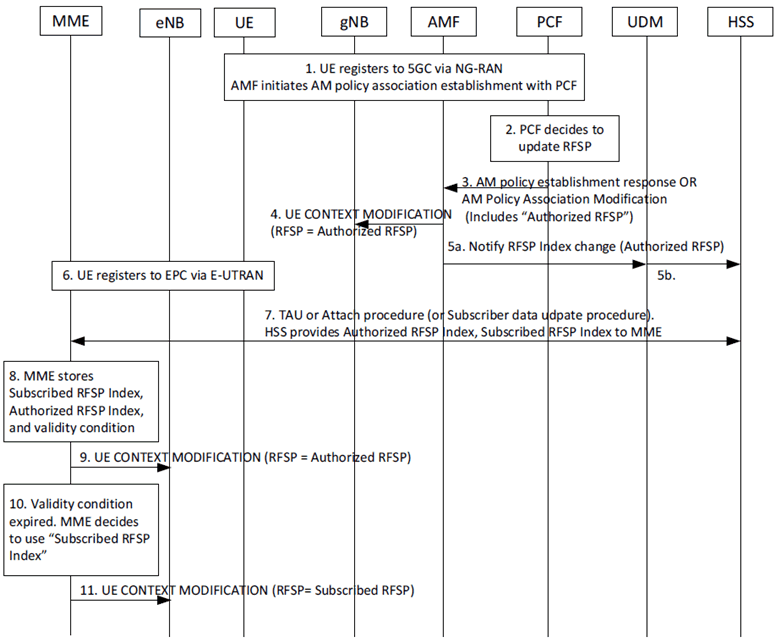Content for TR 23.700-89 Word version: 18.0.0
6.2 Solution #2: Provide Authorized RFSP in EPC via UDM/HSS, during 5GS to EPS mobility
6.2.1 Description
6.2.2 Procedures
6.2.3 Impacts on services, entities and interfaces
...
...
6.2 Solution #2: Provide Authorized RFSP in EPC via UDM/HSS, during 5GS to EPS mobility p. 11
6.2.1 Description p. 11
The solution address KI#1 and applies to 5GC to EPC interworking when:
- 5GS to EPS handover using N26 interface.
- 5GS to EPS Idle mode mobility using N26 interface.
- 5GS to EPS Mobility without N26 interface.
- Based on various analytics and prediction result from NWDAF (e.g. network congestion in 5G) the PCF may request to move some of the "5G prioritized" UEs to 4G access.
- According to a request from AF, the PCF may request RAN to move the requested UE(s) from 5G to 4G.
6.2.2 Procedures p. 12

Figure 6.2.2-1: Procedure to Provide Authorized RFSP in EPC via UDM/HSS, during 5GS to EPS mobility
(⇒ copy of original 3GPP image)
(⇒ copy of original 3GPP image)
The detailed procedure is described in Figure 6.2.2-1.
Step 1.
The UE registers to 5GC via NG-RAN. AMF establishes AM Policy association with PCF as in clause 4.16.1.2 of TS 23.502.
Step 2.
The PCF decides to adjust the RFSP index to direct the UE from 5G to 4G. The PCF decision could be based on various inputs. For example:
Step 3.
- Based on various analytics and prediction result from NWDAF (e.g. network congestion in 5G).
- According to the request from AF.
The PCF provides the new "Authorized RFSP" for the UE by initiating AM Policy Modification procedure as in clause 4.16.2.2 of TS 23.502.
Step 4.
The AMF provides the Authorized RFSP as the RFSP to use to the gNB by initiating a UE CONTEXT MODIFICATION procedure as in clause 8.3.4 of TS 38.413.
Step 5.
If N26 does not apply and the AMF identifies that the "Authorized RFSP" is different than the "Subscribed RFSP", then the AMF notifies the UDM on the "Authorized RFSP" received from PCF. If the UDM and HSS are deployed separately then the UDM further notifies the "Authorized RFSP" to the HSS. In a combined UDM+HSS deployment this step (5b in Figure 6.2.2-1) is not needed or handled in implementation specific way.
Step 6-7.
When the UE was guided to 4G access, the UE performs TAU or Attach procedure, during which the HSS provides "Authorized RFSP" to the MME serving the UE, along with the "Subscribed RFSP".
Step 8.
The MME stores the "Subscribed RFSP", the "Authorized RFSP" and a validity condition for the "Authorized RFSP" in the UE context in MME. The validity condition may be locally configured at the MME based on operator policy and may contain a duration for which the "Authorized RFSP" is applicable (e.g. timer or current registration etc.). During inter MME handover, the source MME also provides the "Authorized RFSP" and the validity condition to the target MME.
Step 9.
The MME may choose to continue using the "Authorized RFSP" instead of deriving the RFSP Index based on the subscribed RFSP Index. The MME provides the "Authorized RFSP" as the RFSP to use to the eNB in UE CONTEXT MODIFICATION procedure as in clause 8.3.4 of TS 36.413.
Step 10.
When the validity condition is expired the MME may review the RFSP index and may choose the RFSP Index to use based on the subscribed RFSP Index, the locally configured operator's policies and the UE related context information available at the MME.
Step 11.
The MME provides the RFSP to use to the eNB in UE CONTEXT MODIFICATION procedure as in clause 8.3.4 of TS 36.413.
6.2.3 Impacts on services, entities and interfaces p. 13
This solution may have the following impacts to existing entities and interfaces:
- AMF: AMF creates subscription for notification of "Authorized RFSP" to UDM/HSS. AMF notifies the "Authorized RFSP" received from PCF to the UDM/HSS
- UDM: When UDM and HSS are deployed separately, the UDM shall create an implicit subscription to send "Authorized RFSP" to HSS. When the USM receives "Authorized RFSP" for a UE from the AMF, it shall send a notification to the HSS.
- HSS: Provides the "Authorized RFSP" along with "Subscribed RFSP" for a UE to the MME. The "Authorized RFSP" may be provided during Update Location or as a Standalone Insert Subscriber Data operation.
- MME: MME stores the "Authorized RFSP" along with its validity conditions in the UE context in MME. As long as the validity condition is satisfied the MME uses "Authorized RFSP" over "Subscribed RFSP". The MME provides the "Authorized RFSP" and its validity conditions to target MME during inter MME mobility. When the validity condition is expired the MME decides to use "Subscribed RFSP".